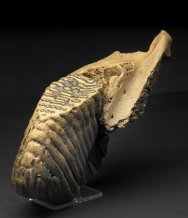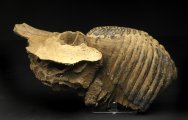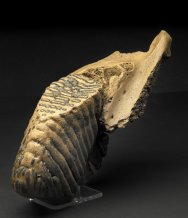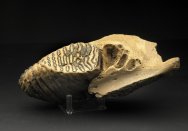 Description:
This beautiful and striking Mammuthus primigenius molar with jaw
section comes directly from the Rhineland region of west central
Germany. The preservation is remarkable and natural mineral replacement
processes in fossilization resulted in a color spectrum of light
brown hues. At 6 lbs 3 oz (2.286 kg), it’s as heavy, solid
and dense as the rock it became since tens of thousands of years
ago when humans were still roving bands of hunter gatherers. This
molar has not been subjected to any chemical preservation processes.
Therefore it is totally natural with no unpleasant chemical smells
or artificial surface sheen. The woolly mammoths met extinction
at the end of the Pleistocene (12,000 years ago), probably as a
result of climate change together with the effects of human hunting.
This is a premium grade mammoth molar. Description:
This beautiful and striking Mammuthus primigenius molar with jaw
section comes directly from the Rhineland region of west central
Germany. The preservation is remarkable and natural mineral replacement
processes in fossilization resulted in a color spectrum of light
brown hues. At 6 lbs 3 oz (2.286 kg), it’s as heavy, solid
and dense as the rock it became since tens of thousands of years
ago when humans were still roving bands of hunter gatherers. This
molar has not been subjected to any chemical preservation processes.
Therefore it is totally natural with no unpleasant chemical smells
or artificial surface sheen. The woolly mammoths met extinction
at the end of the Pleistocene (12,000 years ago), probably as a
result of climate change together with the effects of human hunting.
This is a premium grade mammoth molar.
The
molars of the woolly mammoth, like those of other mammoths and elephants
were large, specialized structures with a flattened grinding surface.
Low ridges of dense enamel run across the surface of the teeth,
making them ideal for grinding grasses. As with mastodons, a mammoth
will have a series of six cheek teeth (premolars and molars) on
each side of the jaw (a total of 24 teeth for both upper and lower
jaws.) Younger mammoths had three teeth on each side, while most
adults had two, and the old animals had one. As the teeth were worn
down, they were replaced by teeth growing in from the back. Newer
teeth were larger and contained more ridges than older teeth.
I also
need to dispel self-serving disinformation I’ve seen on the
Internet regarding Mammoth teeth from German Polish and Siberian
sedimentary deposits, compared with those brought up from the sea.
The former are clearly more aesthetic, and the natural preservation
and structural integrity has not been compromised by the adverse
chemical effects and dissolution during sea water submersion as
in the later. The former smells like the rock that it is and the
later smells like the hydrocarbons required to restore structure
integrity with many shellac-like coating. At the 2008 Tucson Fossil
show, the former were scarce and relatively expensive, and later
were prevalent and pretty inexpensive. Pitching fossils as investments
reminds me of the coin and pawn shop near where I grew up. If I
thought fossils were good investment vehicles, I would recommend
Mammoth teeth from Northern Europe and Siberia, so don’t be
duped by the disinformation. The Mammoth teeth from the North Sea
are just fine, especially since they should be a bargain compared
to those from Siberia, if you don’t mind the smell.
|



